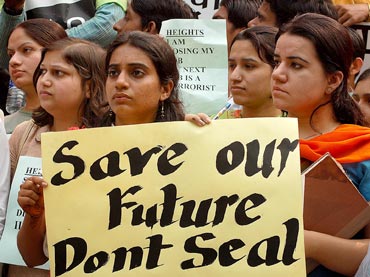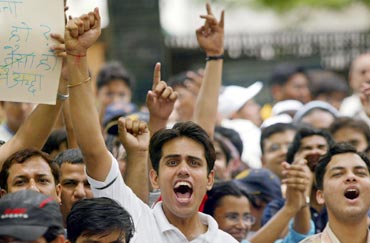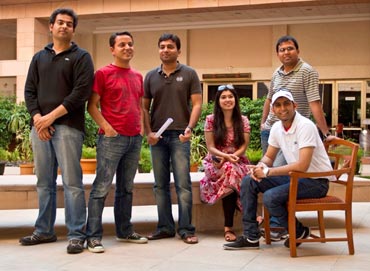Photographs: Rediff Archives
For former head of the University Grants Commission, Yash Pal, students scoring 100 per cent should be given negative marking. For, in the race to 'mug up', they would have learnt nothing and washed out their creativity.
That's obviously an extreme view, but Pal, who two years ago chaired a 24-member Committee on reforming higher education, has reasons to feel disappointed at the decision of Shri Ram College of Commerce (SRCC) to fix 100 per cent cut-off marks for admission.
"We train our students to work for others. Indian colleges teach their students to make nuts and bolts, and the so-called specialisation that institutes talk about is highly unrealistic. Even IITs are nothing but undergraduation factories," says Pal.
(Additional reporting by Piyali Mandal)
For DU cut-offs click HERE.
Do you know what the college cut-offs are in your city?
What is the cut-off for the first list in Chennai's best science college? Or the arts cut-off in Bangalore's top colleges?
If you have information on this year's college admissions, simply fill in the form below. The information you share just might help students gain admission into their dream college. (note: e-mail addresses will not be disclosed.)
100% cut-off symptom of a disease, says Yash Pal
Photographs: Adnan Abidi / Reuters
His report on 'Renovation and Rejuvenation of Higher Education' that he gave to the Ministry of Human Resource Development in June 2009, is nowhere close to implementation.
Among other recommendations, the committee proposed a national testing scheme for university admissions on the lines of Graduate Record Examinations, an admission requirement for many colleges in the United States, open to all aspirants and to be held more than once a year.
Human resource development minister Kapil Sibal promised the same yesterday after SRCC's decision became public, but Pal isn't convinced. "The ministry is so caught up with little things that it does not have the time to look at bigger issues," says Pal.
That hardly means anything for Nitya Batra, a commerce student from DPS, Indirapuram, in New Delhi. "SRCC's decision is unrealistic. Even colleges like Kamla Nehru have raised the bar and are asking for 98-99 per cent. Students, with such high percentage marks, would rather prefer Hindu or Keshab Mahavidyalaya but not Kamla Nehru. In this process, students like us are left out," says Batra.
Batra says it is also difficult for students to change their streams. For an Arts student to get admission in Khalsa college, the cut-off is way below 90 per cent. But for a commerce student, the cut-off is 92 per cent. "I can't change my interest to get into a good college. My parents are supporting me and I will not choose a college over a course," she says.
100% cut-off symptom of a disease, says Yash Pal
Batra is certainly not alone in the country, which ironically has the largest higher education system in the world in terms of number of institutions and the third-largest in terms of student enrollment. While India has 26,000 institutes across varied fields of study, the US has 6,706 higher education institutions and China has 4,000.
Since 1951, the number of universities in India has increased from 28 to 504, while the number of colleges have grown from 578 to 25,951.
A recent report of Ernst & Young estimated spends on higher education in India at nearly Rs 46,200 crore, with 92 per cent of it coming from private institutes. The report projected it to grow over Rs 150,000 crore in 10 years.
The dean of a management institute in Mumbai says the present set-up promotes nepotism. It looks at controlling the educational system by doling out licences to politicians and their kins. Distributing licences in this manner promotes distortions, and there are no transparent mechanism to ensure that information on education institutions are made available to students and their parents. "So, an area where the government shouldn't play an active role, it is extremely active. And, where it should play its role, it is either absent or doing little," the dean says.
100% cut-off symptom of a disease, says Yash Pal
It was due to the government's over-regulation that M L Srikant, dean of S P Jain Institute of Management and Research in Mumbai, had to discontinue a successful programme that it entered into with Virginia Tech of the US.
"We had a capacity of 80 seats, where as the amount of applications we got, we could have filled 800 seats. With every student landing four job offers, we could have placed all the students, too. But the government did not allow us to continue the programme beyond two years. It was a similar struggle with the All India Council for Technical Education for four years to increase its class size from 120 to 180 at present," laments Srikant.
Last year, around 60,000, or 30 per cent, of the existing 200,000 management seats remained vacant. This is the highest vacancy ever in management education, with institutions even accepting money and selling seats to students without entrance test scores.
Engineering institutes also faced a similar situation. Nearly 530,000, or 40 per cent, of the 1.32 million seats remained unoccupied.
Sibal last year allowed an additional 200,000 engineering, 80,000 management and 2,200 architecture seats.
Amitabh Jhinghan, partner and education sector leader, Ernst & Young, says extra supply and low demand are a clear case of lack of quality institutions in the country.
"The government needs to quickly focus on expanding the capacity of quality higher education institutions. It can let some quality existing institutions to take over not-so-good institutions and improve their quality and enrollments, too," says Jhinghan.
Capacity constraint in domestic institutes offering quality programmes is one of the main reasons why more and more students are opting to study abroad, making India the second-largest source of international students after China.
For instance, between 2005 and 2009, test takers for Graduate Management Aptitude Test grew from 13,544 to 30,633, reflecting a compounded annual growth rate of 17.7 per cent. Over 50 per cent of Indian students opt to study in the US.






Comment
article